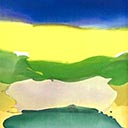Laughing Kookaburras
69.9 x 54.6 cm
est. $15,000 - 20,000
Provenance: Purchased from International Art Centre 1979
Private Collection, Queensland
Private Collection, Northland
Exhibited: International Art Centre 1979
Illustrated: p. 74 Sketches and Studies of a Bird Painter, Raymond Ching and Errol Fuller, Landsdowne Editions 1981
The Laughing Kookaburra dacelo novaeguineae is widely known, not just in its native Australia but throughout much of the world. The species is recognised by an unusually distinctive laughing cry, which has given rise to a number of popular names. Perhaps the most commonly used is 'the Laughing Jackass'; another, 'the Bushman's Clock', is a reference to the bird's habit of calling mostly loudly either early in the morning or around sunset. The sound produced is exceptionally loud and prolonged, and usually is delivered with the head tilted upwards while the tail flicks up and down.
Kookaburras are handsome birds. Their appearance is quite as distinctive as their call. They are, in fact, among the largest living representatives of the kingfisher family. To those familiar only with the smaller, more elegant species of this family, the length of 45cm and the Kookaburra's bulky appearance can be a surprise. The beak looks exceptionally weighty and impressive, and is clearly a formidable weapon. The feet and legs, however, are comparatively weak and the wings are not well adapted to sustained periods of flight. The Laughing Kookaburra is distributed throughout much of eastern and southern Australia; its range has been extended further by introductions into western parts of the country in 1898 and Tasmania in 1905. Kookaburras are common wherever suitable conditions exist and although originally the birds inhabited areas of open forest, they now can be seen in urban parks and gardens, where individuals are said to become quite tame. Although it is possible to see single birds, Kookaburras are more likely to be observed in pairs or small parties, especially in the evening. The birds nest in holes in trees and usually breed between the months of September and January. As with so many members of the kingfisher family, Kookaburras are by no means only fish eaters. Essentially a forest species, they take a wide assortment of prey and will eat most living things small enough to be vulnerable to an attack. The nests of other bird species are at risk, and rodents, frogs and lizards are all consumed when available. Farmyards sometimes are raided and the chicks of domestic fowl and duck are threatened. Although they may represent something of a nuisance, Kookaburras compensate for such behaviour by taking a variety of creatures that are considered pests, including many kinds of insects. The birds probably are most renowned for their alleged partiality for snakes, a habit that though overemphasised, no doubt has contributed further to the Kookaburra's popularity.
Sketches and Studies of a Bird Painter, Landsdowne Editions 1981





